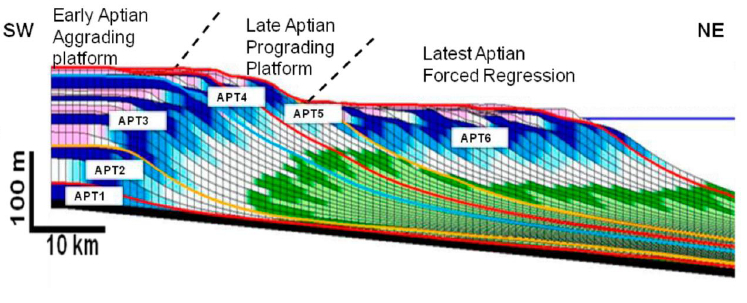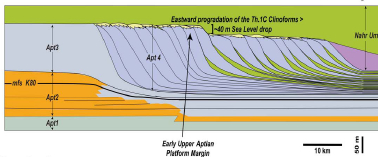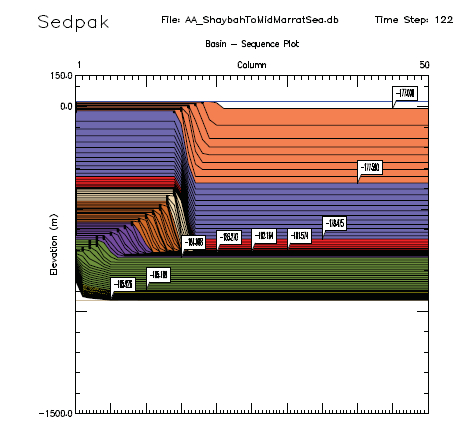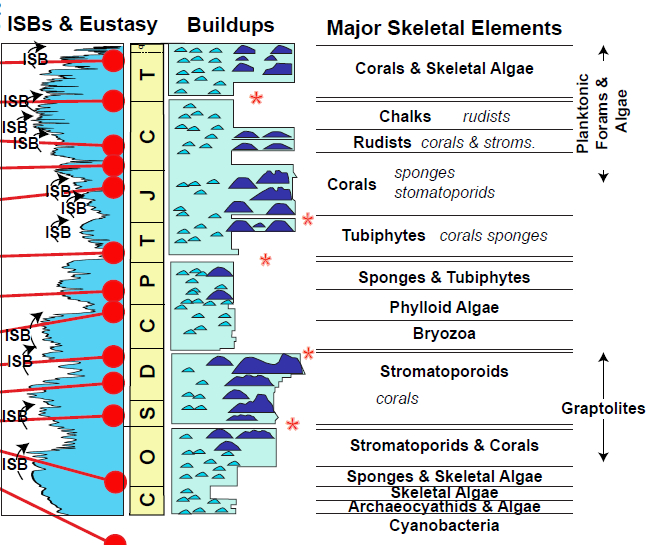The literature related to the geology of the intrashelf basins of the Arabian Plate is immense and ever growing. The most comprehensive collections of papers are those of GeoArabia and the AAPG and some of these are listed in the annotated Bibliography below. For more illustrations and conceptual ideas you should visit the Search and Discovery pages of the AAPG website. Links to some of these pages include:
Links to Pdf files of Recent Posters of Arabian Plate ISBs
| Borgomano Jean, Lanteaume Cyprien, Ridet Olivier, Rousseau Mathieu, and Vilasi-Marmier Nadège, 2014, 3D Stratigraphic Forward Modelling for the Prediction of carbonate Platform Architectures: Evaluation of Stratigraphic Trap Potential in Middle East Mesozoic carbonate sequences; Search and Discovery Article #41328 AAPG. |
 |
De Keyser Tom, Kendall Christopher G., 2014, Jurassic and Cretaceous sedimentary fill of intrashelf basins of the Eastern margin the Arabian Plate, 2014 AAPG Annual Convention and Exhibition, 6-9 April, 2014, Search and Discovery AAPG Posters,#30322 (2014)
|
 |
Kendall, Christopher G., Moore, Phil; Viparelli, Enrica; Alsharhan, Abdulrahman S., De Keyser, Tom; and Kloot, Cameron: Simulation and analysis of sequence stratigraphic models for the Jurassic Cretaceous sedimentary fill of the Eastern margin the Arabian Plate; 2014 AAPG Annual Convention and Exhibition, 6-9 April, 2014, Search and Discovery AAPG Posters, #30326 (2014)
|
 |
| De Keyser Thomas, and Kendall, Christopher, 2014, Intrashelf basins respond to plate tectonic movement and paleogeographic position, Proceedings of SEPM Research Conference Autogenic Dynamics of Sedimentary Systems, August 3-6, 2014, Grand Junction, CO, USA ; Abstract, p 35. |
 |
Bibliography Related to Arabian Plate ISBs (Many sourced from van Buchem publications)
Ahr, W. M., 1973,
The carbonate ramp: an alternative to the shelf model:
Transactions of the Gulf Coast Association of Geological Societies, v. 23, p.
221–225.
Alsharhan, A. S., 1995, Facies variations,
diagenesis, and exploration potential of the Cretaceous rudist-bearing carbonates
of the Arabian Gulf: AAPG Bulletin, v. 79, p. 531–550.
Alsharhan,
A. S., and A. E. M. Nairn, 1988, A review of the Cretaceous formations
in the Arabian Peninsula and Gulf—part II: mid-Cretaceous (Wasia Group) stratigraphy
and paleogeography: Journal of Petroleum Geology, v. 11, p. 89–112.
Alsharhan,
A. S., and A. E. M. Nairn, 1997, Sedimentary basins and
petroleum geology of the Middle East: Amsterdam, Elsevier, 843 p.
Alsharhan,
Abdulrahman, & Kendall, C.G.St.C., 1986, Precambrian to Jurassic rocks of
the Arabian Gulf and adjacent areas: Their facies, depositional setting and
hydrocarbon habitat: AAPG Bull., v. 70, p. 977-1002.
Alsharhan,
Abdulrahman, & Nairn, A. E. M., 1988.
A review of the Cretaceous formations
in the Arabian Peninsula and Gulf, Part II. Mid-Cretaceous (Wasia Group)
stratigraphy and paleogeography: Jour. Petr. Geol., v. 11, p. 89-112.
Alsharhan,
Abdulrahman, 1989. Petroleum Geology of the United Arab Emirates: Jour. Petr.
Geol., v. 13, p. 253-288.
Arthur, M. A., S. O. Schlanger,
and H. C. Jenkyns, 1987, The Cenomanian–Turonian oceanic anoxic event: II.
paleoceanographic controls on organic matter production and preservation, in J. Brooks and A. Fleet, eds., Marine petroleum source rocks: Geological Society Special
Publication, v. 26, p. 401–420.
Azzam, I., 1997,
Exploration model for the middle Cretaceous Mishrif carbonate
platform along Shilaif basin in Abu Dhabi,U.A.E. (abs.):
GeoArabia, v. 2, p. 480.
Be´chennec, F., R. Wyns, J.
Roger, J. Le Metour, and S. Chevrel, 1992, Geological map of Nazwa (including
explanatory notes): Sultanate of Oman, Ministry of Petroleum and Minerals,
scale 1:250,000, sheet NF 40-07.
Burchette, T. P., 1993,
Mishrif Formation (Cenomanian–Turonian), southern Arabian
Gulf: carbonate platform growth along a Cratonic basin
margin, in J. A. T. Simo, R. W. Scott, and J. P. Masse, eds., Cretaceous carbonate
platforms: AAPG Memoir 56, p. 185–199.
Burchette, T. P.,
and P. Wright, 1992,
Carbonate ramp depositional systems:
Sedimentary Geology, v. 79, p. 3–57.
Burchette, T. P.,
and S. R. Britton, 1985, Carbonate facies analysis in the
exploration for hydrocarbons—a case study from the Cretaceous of the Middle
East, in P.
J. Benchley and B. P. J. Williams, eds., Sedimentology, recent developments and
applied aspects: Oxford, Blackwell, p. 311–338.
Coakley,
B., 1995, Far-field tilting of Laurentia during the Ordovician and constraints
on the evolution of a slab under an ancient continent: Journal of Geophysical
Research, v. 100, no. B4, p. 6313–6327.
Connally, T. C.,
and R. W. Scott, 1987, Shelf and intrashelf basin facies of
the middle Cretaceous, Rub-Al-Khali Basin, southern Arabian
Peninsula (abs.): SEPM midyear meeting, v. 4, p. 17.
Cortis,
A. L., A. Wenche, and J. R. Borgomano, 2001, Comparative seismo-stratigraphic
architecture of two Cretaceous carbonate platform seqences:
influence of local tectonics and sea-level fluctuations on development of
reservoir architecture: Society of Petroleum Engineers paper 68145.
Cross, T. A., et al., 1993, Applications of high-resolution seqence stratigraphy to reservoir analysis, in R. Eschard and B. Doligez, eds., Proceedings of the 7th Exploration Production Research Conference: Paris, Editions Technip, p. 11–33.
Daniel, J. M., and J.-M. Mengus, 2000, Outcrop study of fracture patterns in the Natih Formation, foothills of the northern Oman Mountains, in
F. S. P. Van Buchem, J. M. Daniel, J.-M. Mengus,P. Homewood, and H. Droste, The
Natih carbonate petroleum system (Cenomanian/Turonian; N.
Oman)—an integrated study of reservoir facies, source rocks and fracture
patterns in a high resolution seqence stratigraphic
framework: AAPG Field Seminar Guidebook, unpaginated.
de
Matos, J. E., & Hulstrand, R. F., 1995,
Regional characteristics and
depositional sequences of the Oxfordian and Kimmeridgian, Abu Dhabi: In M. I.
Al-Husseini (Ed.), Middle East Petroleum Geosciences, GEO’94. Gulf PetroLink,
Bahrain, v. 1, p. 346–356.
Demaison, G. J., and B. J.
Huizinga, 1991, Genetic classifications of petroleum systems: AAPG Bulletin, v.
75, p. 1626–1643.
Droste, H., 1990,
Depositional cycles
and source rock development in an epeiric intra-platform basin:
the Hanifa Formation of the Arabian Peninsula: Sedimentary
Geology, v. 61, p. 281–296.
Droste, H., and M. van
Steenwinkel, 2000,
Strata geometries and patterns within Cretaceous platform carbonates,
the Natih Formation of Oman (abs.): GeoArabia, v. 5, p.
83–84.
Eberli, G. P., K. D. Rawnsley, and W. Kolkman,
2001, Combining high resolution seqence stratigraphy
and mechanical stratigraphy for improved reservoir
characterisation, Fahud field, Oman, (abs.): AAPG Annual Convention, Program
with Abstracts, v. 10, p. A55.
Gale, A. S., 1995, Cyclostratigraphy
and correlation of the Cenomanian of western Europe, in M. R. House and
A. S. Gale, eds., Orbital forcing timescales and cyclostratigraphy:
Geological Society Special Publication 85, p. 177–197.
Gale,
A. S., H. C. Jenkyns, W. J. Kennedy, and R. M. Corfield, 1993, Chemostratigraphy
versus biostratigraphy: data from around the
Cenomanian–Turonian boundary: Journal of the Geological Society, v. 150, p.
29–32.
Glennie, K. W., M. G. A. Boeuf, M. W.
Hughes-Clarke, M. Moody- Stuart, W. F. H. Pilaar, and B. M. Reinhardt, 1974,
Geology of the Oman Mountains (parts 1, 2 and 3): The Hague, Martinus Nijhoff,
Verhandelingen Koninklijk Nederlands Geologisch en Mijnbouw Genootschap, v. 31,
423 p.
Goldhammer, R. K., P. A. Dunn, and L. A. Hardie,
1990,
Depositional cycles, composite sea level changes, cycle stacking
patterns, and the hierarchy of stratigraphic forcing—examples from platform carbonates
of the Alpine Triassic: Geological Society of America Bulletin, v. 102, p.
535–562.
Grabowski, G. J., and I. O. Norton, 1995,
Tectonic controls on the Stratigraphic architecture and hydrocarbon systems of
the Arabian plate, in M. I. Al-Husseini, ed., Middle East petroleum geosciences, GEO
’94: Selected papers from the Middle East Geosciences Conference and Exhibition
in Bahrain, Manama, Gulf Petrolink, v. 1, p. 413–430.
Granjeon,
D., and F. S. P. van Buchem, 2000, 3-D stratigraphical modeling of the Natih Formation
(Upper Cretaceous, northern Oman) (abs.): GeoArabia, v. 5, p. 95–96.
Grantham, P. J., G. W. M. Lijmbach, J. Posthuma, M. W. Hughes Clarke, and R. J. Willink, 1987, Origin of crude oils in Oman: Journal of Petroleum Geology, v. 11, p. 61–80.
Gurnis, M., 1992, Rapid continental subsidence following the initiation and evolution of subduction: Science, v. 255, p. 1556– 1558.
Haq Bilal U., and Al-Qahtani Abdul Motaleb, 2005, Phanerozoic cycles of sea-level change on the Arabian Platform, GeoArabia, Vol. 10, No. 2, Gulf PetroLink, Bahrain
Haq, B. U., J. Hardenbol, and P. R.
Vail, 1988, Mesozoic and Cenozoic chronostratigraphy
and cycles of sea-level change, in C. K. Wilgus, H.
Posamentier, B. S. Hastings, J. van Wagoner, C. A. Ross, and C. G. St. C.
Kendall, eds., Sea-level changes— an integrated approach: SEPM Special
Publication 42, p. 71– 108.
Hardenbol, J., J. Thierry, B.
Martin, Th. Jacquin, P.-Ch. de Graciansky, and P. R. Vail, 1998, Mesozoic and
Cenozoic seqence chronostratigraphic framework of European basins,
in P.-Ch.
de Graciansky, , J. Hardenbol, Th. Jacquin, and P. R. Vail, Mesozoic and
Cenozoic seqence stratigraphy of European basins:
SEPM Special Publication 60, p. 3–14.
Harris, P. M., and
S. H. Frost, 1984, Middle Cretaceous carbonate reservoirs,
Fahud field and northwestern Oman: AAPG Bulletin, v. 68, p. 649–658.
Harris,
P. M., S. H. Frost, G. A. Seiglie, and N. Schneidermann, 1984,
Regional unconformities
and depositional cycles, Cretaceous of the Arabian Peninsula, in J. S. Schlee, ed., Interregional unconformities and hydrocarbon
accumulations: AAPG Memoir
36, p. 67–80.
Hassan, T. H., Mudd, G. C., & Twombley,
B. N., 1975. The stratigraphy and sedimentation of the
Thamama Group (Lower Cretaceous of Abu Dhabi): 9th Arab. Petr. Congr., Dubai,
11 p.
Herbin, J. P., E. Masure, and J. Roucach, 1987,
Cretaceous formations from the lower continental rise off
Cape Hatteras: organic geochemistry, dinoflagellate cysts, and the Cenomanian/
Turonian boundary event at sites 603 (Leg 93) and 105 (Leg 11), in J. E. van Hinte
and S. W. Wise, eds., Initial reports of the Deep Sea Drilling Project:
Washington, D.C., U.S. Government Printing Office, v. 93, p. 1139–1162.
Homewood, P. W., 1996,
The carbonate feedback system: interaction between stratigraphic accommodation,
ecological succession and the carbonate factory: Bulletin
Societe´ Geologique de France, v. 6, p. 685–700.
Homewood,
P. W., and G. P. Eberli, eds., 2000, Genetic stratigraphy:
case studies from the Carboniferous of the Paradox basin, and
the upper Devonian of western Canada: Bulletin Centre Recherche Elf Exploration
Production, Memoir 24, 290 p.
Homewood, P. W., P.
Mauriaud, and F. Lafont, 2000, Best practices in seqence stratigraphy
for explorationists and reservoir engineers: Bulletin Centre Recherche Elf
Exploration Production, Memoir 25, 81 p.
Homewood, P.,
F. Guillocheau, R. Eschard, and T A. Cross, 1992, Correlations haute resolution
et stratigraphie genetique: une demarche integre: Bulletin Centre Recherche Elf
Exploration Production, v. 16, p. 357–381.
Hughes Clarke,
M. W.,1988, Stratigraphy and rock unit nomenclature in the
oil-producing area of interior Oman: Journal of Petroleum Geology, v. 11, p.
5–60.
Immenhauser, A., A. Creusen, M. Esteban, and H. B.
Vonhof, 2000,
Recognition and interpretation of polygenic discontinuity surfaces
in the middle Cretaceous Shuaiba, Nahr Umr, and Natih formations
of northern Oman: GeoArabia, v. 5, p. 299–322.
Jenkyns,
W. J. Kennedy, and R. M. Corfield, 1993, Chemostratigraphy
versus biostratigraphy: data from around the
Cenomanian–Turonian boundary: Journal of the Geological Society, v. 150, p.
29–32.
Jordan, C. F., T. C. Connally, and H. A. Vest,
1985, Middle Cretaceous carbonates of the Mishrif Formation,
Fateh field, offshore Dubai, in P. O. Roehl and P. W. Choquette, eds., Carbonate
petroleum reservoirs: New York, Springer-Verlag, p. 425–442.
Kendall,
C. G., A. S. Alsharhan, and L. Marlow, 2014 Straigraphy and depositional systems
of the Southern Tethyan Region In: Petroleum Systems of the
Tethyan Region - Lisa Marlow, Christopher C. G. Kendall, and Lyndon A. Yose,
(Eds.), American Association Petroleum Geologists Memoir 106, p 29-58
Kennedy,
W. J., and M. D. Simmons, 1991, Mid-Cretaceous ammonites and associated
microfossils from the central Oman Mountains: Newsletter in Stratigraphy,
v. 25, p. 127–154.
Kerans, C., and S. Tinker, 1997, Seqence
stratigraphy and characterisation of carbonate
reservoirs: SEPM Short Course Notes 40, 130 p.
Kolkman,
W. H., R. J. Berkhout, and C. N. Nicholss, 2001, Integrated fracture modelling
as the key to re-moving the limits in the appraisal and development of the
Fahud field: Society of Petroleum Engineers paper 68191.
Le
Me´tour, J., J. C. Michel, F. Be´chennec, J. P. Platel, and J. Roger, 1995,
Geology and mineral wealth of the Sultanate of Oman: Directorate General of
Minerals, Oman Ministry of Petroleum and Minerals, 285 p.
Loucks, R. G., and J. F. Sarg, eds., 1993, Carbonate sequence
stratigraphy, recent developments and applications: AAPG
Memoir 57, 545 p.
Marlow, Lisa; Christopher C. G.
Kendall, and Lyndon A. Yose, (Eds) 2014 Petroleum Systems of
the Tethyan Region, American Association Petroleum Geologists Memoir 106, pp
757
Massaferro, J. L., E. Morettini, and G. P. Eberli,
2001,
Stratigraphic control on reservoir heterogeneity in cyclic carbonates—
examples from the upper Thamama Group and Natih Formation,
Abu Dhabi and Oman: Society of Petroleum Engineers paper 68196.
Maurer,Florian, Frans S.P. van Buchem, Gregor P. Eberli, Bernard J. Pierson, Madeleine J. Raven, 2013, Late Aptian long-lived glacio-
eustatic lowstand recorded on the Arabian Plate, Terra Nova Volume 25, Issue 2, pages 87–94.
Montenat, C., H.-J. Soudet, P. Barrier, and A. Chereau, 1999, Karstification and tectonic evolution of the Jabal Madar (Adam Foothills, Arabian platform) during the Upper Cretaceous: Bulletin Centre Recherche Elf Exploration Production, v. 22,
p. 161–183.
Murris, R. J., 1980, Middle East:
stratigraphic evolution and oil habitat: AAPG Bulletin, v. 64, p. 597–618.
Pascoe, R. P., N. P. Evans, and T. L. Harland, 1995, The generation of unconformities
within the Mishrif and Laffan formations of Dubai and
adjacent areas: applications to exploration and production, in M. I.
Al-Husseini, ed., Middle East petroleum geosciences: GEO ’94, v. 2, p. 749–760.
Patton, T. L., and S. J. O’Connor, 1988, Cretaceous flexural history of northern Oman Mountain foredeep, United Arab Emirates: AAPG Bulletin, v. 72, p. 797–809.
Phelps, Ryan M., Charles Kerans, Robert G. Loucks, Rui O.B.P. Da Gama, Jason Jeremiah and David Hull, 2014 Oceanographic and
eustatic control of carbonate platform evolution and sequence stratigraphy on the Cretaceous (Valanginian–Campanian) passive margin, northern Gulf of Mexico, Sedimentology, 61, 461–496
Philip, J., 1994,
Seqences and systems tracts of a mixed carbonatesiliciclastic platform basin setting: the Cenomanian–Turonian of the
Provence (south-eastern France): Geologie Mediterrane enne, v. 21, p. 149–152.
Philip,
J., and Ch. Airaud-Crumie` re, 1991, The demise of the rudist bearing carbonate
platforms at the Cenomanian/Turonian boundary: a global control: Coral Reefs,
v. 10, p. 115–125.
Philip, J., J. Borgomano, and S.
Al-Maskiry, 1995, Cenomanian–early Turonian carbonate
platform of northern Oman: stratigraphy and
paleo-environments: Paleogeography, Paleoclimatology and Paleoecology, v. 119,
p. 77–92.
Philip, J., J. P. Masse, and H. Bessais, 1989,
Organisation et evolution sedimentaire d’une marge de plate-forme carbonatee:
l’Albien– Cenomanien de Tunisie centrale: Geologie Mediterraneenne, v. 16, p.
155–169.
Pomar, L., 1991,
Reef geometries, erosion
surfaces and highfrequency sea level changes, upper Miocene reef complex,
Mallorca, Spain: Sedimentology, v. 38, p. 243–269.
Pratt, B. R., and J. D. Smewing, 1993, Early Cretaceous platform margin configuration
and evolution in the central Oman Mountains, Arabian Peninsula: AAPG Bulletin,
v. 77, p. 225–244.
Pratt, L. M., and C. N. Threlkeld,
1984, Stratigraphic significance of C13/C12 ratios in
mid-Cretaceous rocks of the Western Interior, USA, in D. F. Stott and
D. J. Glass, eds., The Mesozoic of middle North America: Canadian Society of
Petroleum Geologists Memoir 9, p. 305–312.
Rabu, D. 1987.
Geologie de l’autochtone des montagnes d’Oman: la fenetre du Jabal Akhdar: la semelle metamorphique de la nappe ophiolitique de Semail dans les parties
orientale et centrale des montagnes d’Oman: une revue: These Doctoral d’Etat,
Universite Pierre et Marie Curie, Paris, Document Bureau Recherche Geologique
et Miniere, Orleans, v. 130, 582 p.
Read, J. F., C. Kerans, and L. J. Weber, 1995,
Milankovitch sea level changes,
cycles and reservoirs on
carbonate platforms in greenhouse and ice-house worlds: SEPM
Short Course Notes 35.
Robertson, A. H. F., 1987, Upper
Cretaceous Muti Formation— transition of a Mesozoic carbonate
platform to a foreland basin in the Oman Mountains:
Sedimentology, v. 4, p. 1123–1142.
Ross, D. J., and P. W.
Skelton, 1993, Rudist formations of the Cretaceous: a
paleoecological, sedimentological and stratigraphical review: Sedimentology
Review, v. 1, p. 73–91.
Schlager, W., 1991, Depositional
bias and environmental change— important factors in seqence stratigraphy:
Sedimentary Geology, v. 70, p. 109–130.
Scott, R. W.,
1990, Chronostratigraphy of the Cretaceous carbonate
shelf, southeastern Arabia, in A. H. F. Robertson, M. P. Searle, and A. C. Ries, eds., The
geology and tectonics of the Oman region: Geological Society Special
Publication, v. 49, p. 89– 108.
Searle, M. P., and J.
Cox, 1999, Tectonic setting, origin, and obduction of the Oman ophiolite:
Geological Society of America Bulletin, v. 111, p. 104–122.
Searle,
M. P., N. P. James, T. J. Calon, and J. D. Smewing, 1983, Sedimentological and
structural evolution of the Arabian continental margin in the Musandan
Mountains and Dibba zone, United Arab Emirates: Geological Society of America
Bulletin, v. 94, p. 1381–1400.
Sharland, P. R., R.
Archer, D. M. Casey, R. B. Davies, S. H. Hall, A. P. Heward, A. D. Horbury, and
M. D. Simmons, 2001, Arabian plate seqence stratigraphy:
GeoArabia, Special Publication 2, 371 p.
Simmons, M. D.,
1994, Micropaleontological biozonation of the Kahmah Group (Early Cretaceous),
central Oman Mountains, in M. D. Simmons, ed., Micropaleontology and hydrocarbon
exploration in the Middle East: London, Chapman and Hall, p. 177–205.
Simmons,
M. D., and M. B. Hart, 1987, The biostratigraphy and
microfacies of the Early to middle Cretaceous carbonates of
Wadi Mi’aidin, central Oman Mountains, in
M. B. Hart, ed., Micropaleontology of carbonate
environments: Chichester, United Kingdom, Ellis Horwood, p. 176–207.
Smith,
A. B, M. D. Simmons, and M. B. Hart, 1990, Cenomanian echinoids, larger
foraminifera, and calcareous algae from the Natih Formation,
central Oman Mountains: Cretaceous Research, v. 11, p. 29–69.
Terken,
J. M. J., 1999, The Natih petroleum system of north Oman: GeoArabia, v. 4, p.
157–180.
Vahrenkamp, V., 1996,
Carbon isotope stratigraphy
of the upper Kharaib and Shuaiba formations: implications for
the Early Cretaceous evolution of the Arabian Gulf area: AAPG Bulletin, v. 80,
p. 647–662.
Vail, P. R., F. Audemard, S. A. Bowman, P. N.
Eisner, and C. Perez- Cruz, 1991,
The stratigraphic signatures of tectonics,
eustacy and sedimentology—an overview, in
G. Einsele, W. Ricken, and A. Seilacher,
eds.,
cycles and
events in stratigraphy: Berlin,
Springer-Verlag, p. 617–659.
van Buchem, F.
S. P., P. L. de Boer, I. N. McCave, and J. P. Herbin, 1995, The organic carbon
distribution in Mesozoic marine sediments and the influence of orbital climatic cycles (England and the western North Atlantic), in A. Y. Huc, ed.,
Paleogeography, paleoclimate, and source rocks: AAPG Studies in Geology, v. 40,
p. 303–335.
van Buchem, Frans S.P., Rémi Eschard, Guy M.J. Desaubliaux, Philippe Razin, Jean-Pierre Platel, Jack Roger, Peter W. Homewood, Thierry Boisseau, Jean-Pierre Leduc, Richard Labourdette, Solange Cantaloube, Jean M. Philip and Gregor P. Eberli, 1996,
High resolution seqence stratigraphy of the
Natih Formation (Cenomanian–Turonian) in northern Oman:
distribution of source rocks and reservoir facies: GeoArabia, v. 1, p. 65–88.
van Buchem, F. S. P., J. M. Daniel, J.-M. Mengus, P. Homewood, and H. Droste, 2000, The Natih carbonate petroleum system (Cenomanian/Turonian; N.
Oman)—an integrated study of reservoir facies, source rocks and fracture
patterns in a high resolution seqence stratigraphic
framework: AAPG Field Seminar Guidebook.
van Buchem,F.S.P., M.I. Al-Husseini, F. Maurer and H.J. Droste (Eds), 2010, Barremian – Aptian stratigraphy and hydrocarbon habitat of the eastern Arabian Plate, GeoArabia Special Publication 4, 2010, Gulf PetroLink, Bahrain
, 2 volumes,614 pages, 5 charts. ISBN 978-99901-10-59-3.
van Wagoner, J. C., H. W. Posamentier, R. M.
Mitchum, P. R. Vail, J. F. Sarg, T. S. Loutit, and J. Hardenbol, 1988, An
overview of the fundamentals of seqence stratigraphy
and key definitions, in C. K. Wilgus, H. Posamentier, B. S. Hastings, J. van Wagoner, C.
A. Ross, and C. G. St. C. Kendall, eds., Sea-level changes—an integrated
approach: SEPM Special Publication 42, p. 39–45.
van
Wagoner, J. C., R. M. Mitchum, K. M. Campion, and V. D., Rahmanian, 1990,
Siliciclastic seqence stratigraphy in well
logs, core and outcrops: concepts for high-resolution correlation of time and
facies: AAPG Methods in Exploration, v. 7, 55 p.
Whyte, S. J., 1995, Natih field, Oman: the use of 3-D seismic in a mature, fractured carbonate reservoir, in M. I. Al-Husseini, ed., Middle East petroleum geosciences: GEO
’94, v. 2, p. 917–925.
Wilgus, C. K., H. Posamentier, B.
S. Hastings, J. van Wagoner, C. A. Ross, and C. G. St. C. Kendall, eds., 1988,
Sea-level changes— an integrated approach: SEPM Special Publication 42, 407 p.
Witt, W., and H. Gokdag, 1994, Orbitolinid biostratigraphy of the Shuaiba Formation (Aptian), Oman—implications for reservoir
development, in M. D. Simmons, ed., Micropaleontology and hydrocarbon
exploration in the Middle East: London,Chapman and Hall, p. 221–252.
** Page generated by Christopher Kendall **